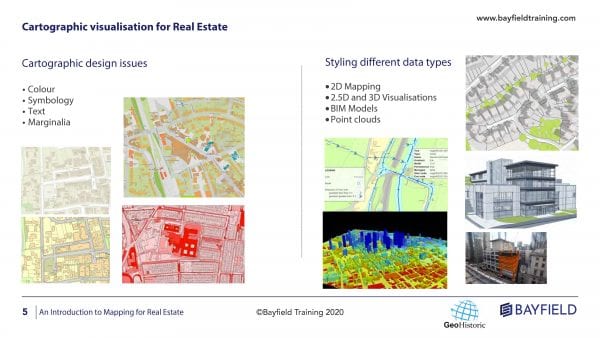In the latest Bayfield Training Webinar, Dr. Seppe Cassettari and Chris Going present: An Introduction to Mapping for Real Estate. This webinar reviewed the types of modern mapping, and the sources used to make it. It addressed the fundamental principles you need to appreciate, such as accuracy and currency, and what resources you might use to build your own geospatial database. The webinar provided a brief overview of the tools that can be applied to analyse data in many different ways, and the cartographic techniques that can create effective graphics that show the extent of your assets and communicate solutions to your problems.
Mapping and GIS: The Basics
Dr Cassettari begins by explaining that mapping databases generally come in two forms—raster or vector. Raster maps are images where the maps are made up of pixels. For example, aerial photographs are a form of raster data. The main difference in a raster map is that you know where each pixel is located on the earth’s surface and the size of each pixel. In contrast, vector maps are made up of points, lines, and areas. Vector maps build up into an integrated map base. Each element in that map base has tags or attributes that describe what is contained within the map. For example, a polygon representing the area of a house can have attributes identifying its age, type, and the number of mortgages associated with it.
Chris Going clarifies that the key to mapping databases is the geospatial reference, the most common of these being the grid reference. Great Britain uses the Ordinance Survey (OS) National Grid. Other forms of common geographic reference include addresses and postcodes.
Key considerations
Next, Dr. Cassettari articulates that when you are using maps from third parties or ones you have created yourself, there are several factors to consider. First, the reliability and validity of the sources used. Moreover, you need to know who owns the data to ensure you do not infringe upon third-party copyright. Second, the level of detail or scale. As Going explains, small scale means a large area but generally less detail, and large scale is a smaller area but more detail. Third, accuracy. Specifically, maps incorporate a level of generalization—the smaller the scale, the greater the generalization. Generalization means that features to some degree are simplified. On smaller-scale maps, the detail can be replaced by symbols. Dr Cassettari. emphasizes that if positional accuracy is essential, you must use the data with the least amount of cartographic interpretation incorporated within it. Fourth, an associated factor with accuracy relates to precision. Precision relates to the number of decimal places a grid reference is recorded. For example, Dr Cassettari clarifies that 10.185 is a higher level of precision than 10.2. Nonetheless, higher levels of precision do not necessarily translate to higher levels of accuracy. The final factor relates to currency. As Going explains, maps are collected at a specific point in time. The publication date on a map does not necessarily indicate the currency of information it contains. Understanding the currency of the mapping you use is vital if you want to ensure the validity of your results. A drawn map today based on an aerial photograph taken a few years ago has a currency linked to the date of the aerial photograph, not the map. Most maps are created from multiple sources; thus, one must understand the currency of each component of the maps database.
Problem-solving using spatial context
The primary advantage of GIS is that it allows you to analyse your information using geography. As Dr Cassettari explains, most information has some form of spatial element and can be analysed in terms of its spatial context. For example, most people use basic techniques, such as mapping personal assets or assessing the proximity of assets to other features.
Going explains the more advanced techniques used for analysing geospatial data. For example, you can apply statistical techniques to attribute data, allowing you to visualise distributions, including the spread of marginal seats in a general election or changes in voting patterns. The more attributes you add to individual map elements, the more you can apply complex multivariate statistics. In addition, using an overlay, you can combine various maps to generate a better understanding of an area.
Cartographic visualisation for Real Estate
Cartographic Design issues
In the final slide, Dr Cassettari explains how to best present your data in a way that can be easily understood and quickly consumed. There are several key factors in generating an effective map. Firstly, the effective and appropriate use of colour. Colour should be used to emphasize what you think are the key takeaways from that map. Second, the use of symbology where the map scale does not allow you to show all the detail of your database. Third, the right amount of text to provide context to the viewer. Fourth, relates to marginalia. That is illustrations on the information on sources and copyright that applies.
Styling different data types
Different cartographic techniques are available depending on both the type of data and type of map you want to create. The greater the level of detail, the greater the need for cartographic clarity. As users interact more with the results from the database, the more you need to give them visual cues to interpret the data effectively. For example, the use of different choices of colour to indicate building heights. In sum, scientific and artistic components of mapping are both equally important.

Written by,
Khathu Nematswerani, Research Intern
